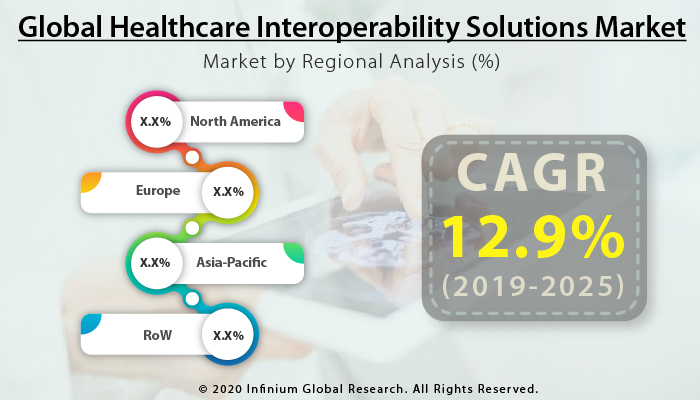Healthcare Interoperability Solutions Market (Type - Software, and Services; Interoperability Level - Structural, Semantic, and Foundational; End-user - Healthcare Providers, Pharmacies, and Healthcare Payers): Global Industry Analysis, Trends, Size, Share and Forecasts to 2025
A recent report published by Infinium Global Research on the healthcare interoperability solutions market provides an in-depth analysis of
segments and sub-segments in the global as well as regional healthcare interoperability
solutions market. The study also highlights the impact of drivers, restraints,
and macro indicators on the global and regional healthcare interoperability
solutions market over the short term as well as long term. The report is a
comprehensive presentation of trends, forecast and dollar values of the global
healthcare interoperability solutions market. According to the report, the
global healthcare interoperability solutions market is projected to grow at a
CAGR of 12.9% over the forecast period of 2019-2025.
Market Insight
The leading players in the healthcare interoperability solutions
market are focusing on technological advancements and innovations. Companies
are adopting strategies such as a merger, acquisitions, and new product
launches that propel market share in the healthcare interoperability solutions
market.
The increasing need for improving the quality of healthcare
facilities drives the growth of the healthcare interoperability solutions
market. The surge in government initiatives to enhance patient care stimulates
the growth of the healthcare interoperability solutions market.
Interoperability reduces the overall cost associated with a delayed diagnosis
that contributes to the growth of the healthcare interoperability solutions market.
The growing adoption of healthcare systems in electronic health record systems
and their integration with critical technologies contribute to the growth of
the healthcare interoperability solutions market. Healthcare interoperability
solutions improve the quality of care. Healthcare interoperability solutions
provide on-time access to data in treatment that promotes the growth of the
healthcare interoperability solutions market. On the flip side, rising
complexity due to lack of consistent data and data privacy issues in healthcare
interoperability solutions hinder the growth healthcare interoperability
solutions market. Moreover, technological advancement in healthcare such as
sharing of data and integration of all medical devices creates novel opportunities
for the growth of the healthcare interoperability solutions market.
Based on geography, the global healthcare interoperability
solutions market is classified into North America, Asia-Pacific, Europe, and
the Rest of the World. North America is expected to have a premium share in the
global healthcare interoperability solutions market. The surge in healthcare
expenditure and the growing demand for quality healthcare delivery contribute
to the growth of the healthcare interoperability solutions market. Asia-Pacific
is anticipated to grow in the global healthcare interoperability solutions
market with a significant CAGR over the forecast period. The rising medical
tourism in the Asia-Pacific region stimulates the growth of the healthcare
interoperability solutions market in the Asia-Pacific region. Europe is showing
growth in the global healthcare interoperability solutions market.

Segment Covered
The report on the global healthcare interoperability solutions market
covers segments such as type, interoperability level, and end-user. On the
basis of type, the sub-markets include software, and services. On the basis of
interoperability level, the sub-markets include structural, semantic, and
foundational. On the basis of end-user, the sub-markets include healthcare
providers, pharmacies, and healthcare payers.
Companies Profiled:
The report provides profiles of the companies in the market such
as Cerner Corporation, Epic Systems Corporation, Koninklijke Philips N.V.,
ViSolve, Inc., Jitterbit Inc., Quality Systems, Inc., Orion Health Group
Limited, Infor, Inc., Allscripts Healthcare Solutions, Inc., InterSystems
Corporation, and Other Companies.
Report Highlights:
The report provides deep insights into the demand forecasts, market trends, and micro and macro indicators. In addition, this report provides insights into the factors that are driving and restraining the growth in this market. Moreover, The IGR-Growth Matrix analysis given in the report brings an insight into the investment areas that existing or new market players can consider. The report provides insights into the market using analytical tools such as Porter's five forces analysis and DRO analysis of healthcare interoperability solutions market. Moreover, the study highlights current market trends and provides forecast from 2019-2025. We also have highlighted future trends in the market that will affect the demand during the forecast period. Moreover, the competitive analysis given in each regional market brings an insight into the market share of the leading players.
